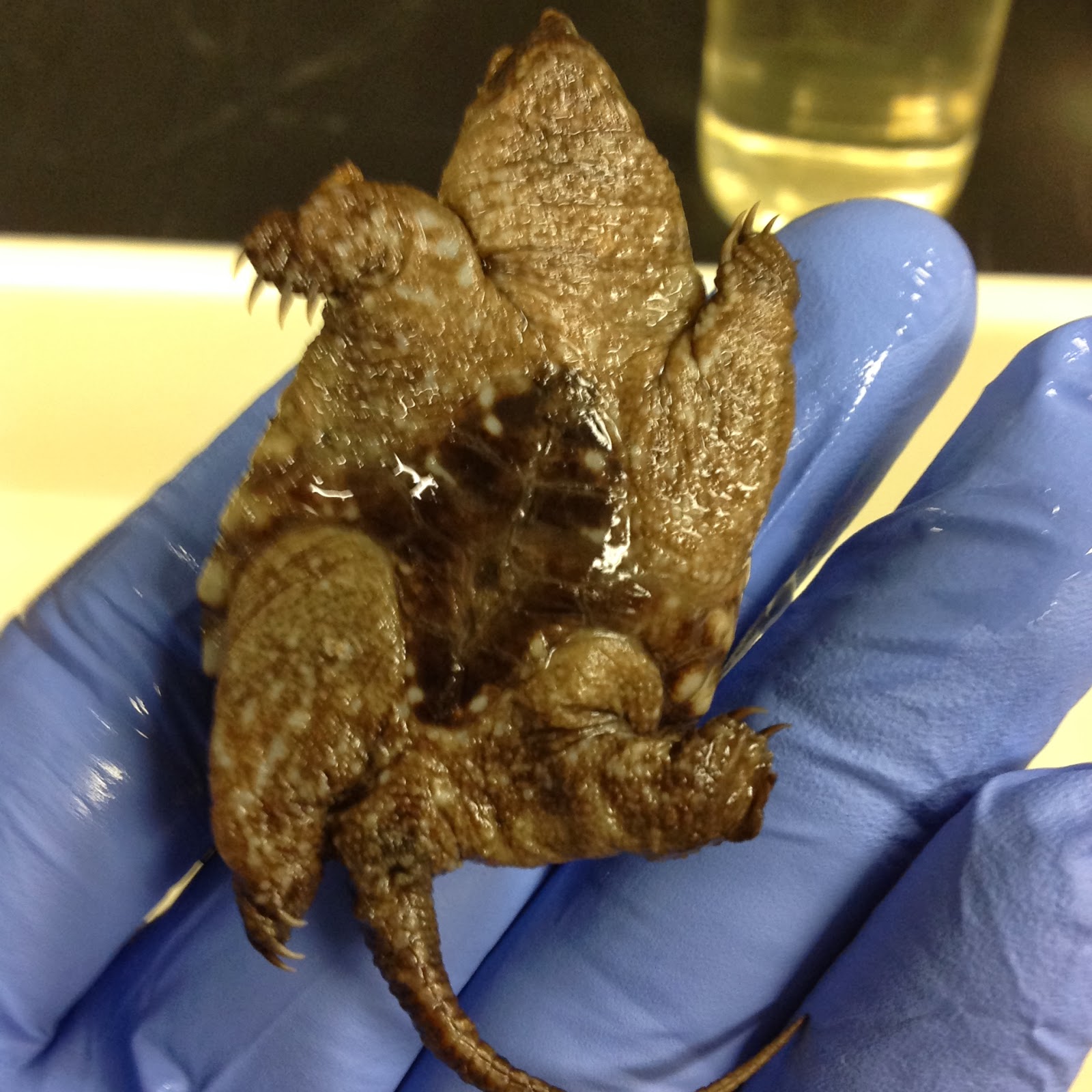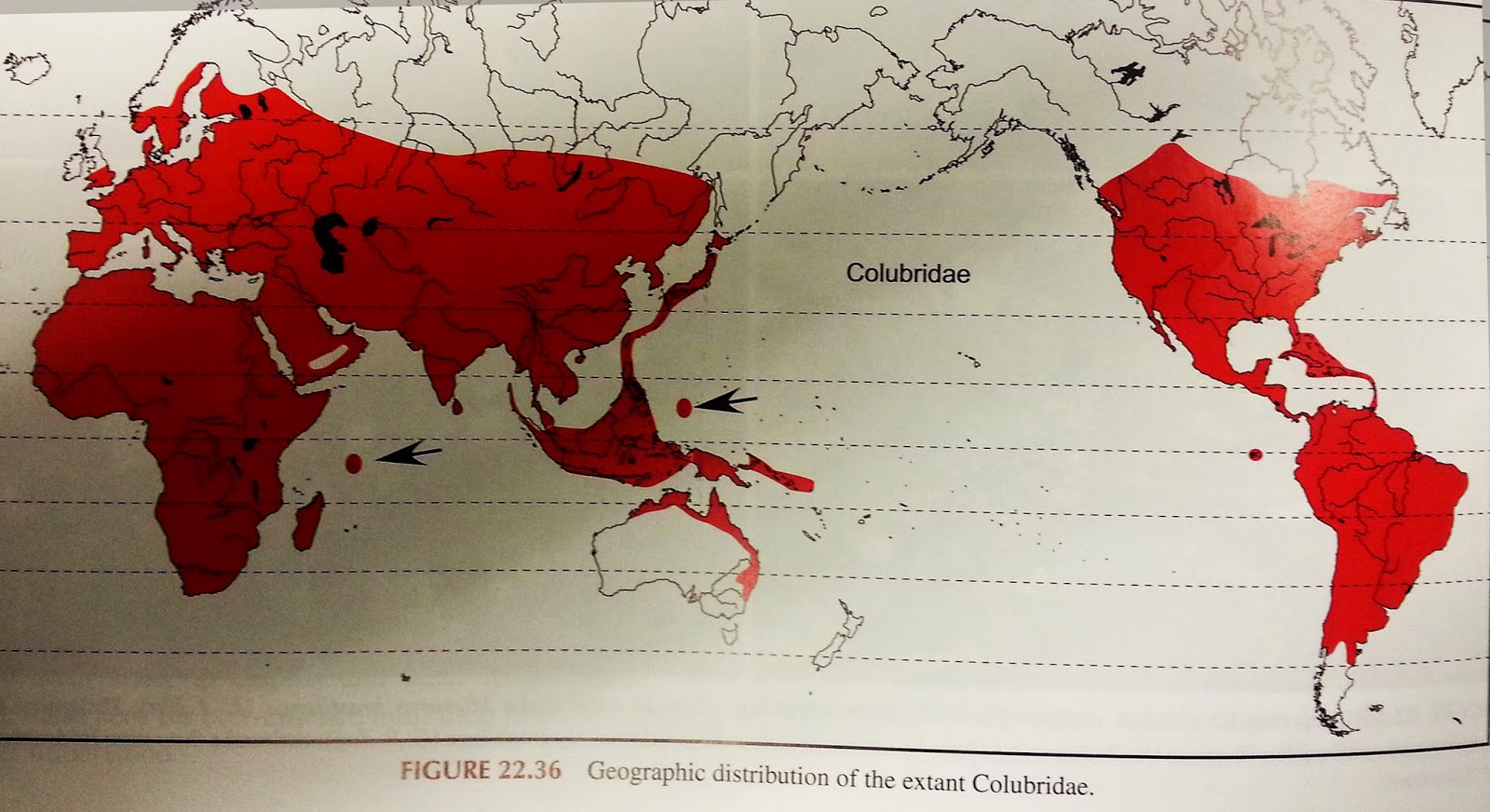In this week's lab we took a trip to the Cleveland Metroparks Zoo to explore the Global Reptile Diversity. Below you will find all of the species which we discovered at the CMZ arranged phylogenetically by Order and alphabetically by Family. Each species account contains the scientific name, the common name, a bit about the animal's biology and it's range, including a photo and a range map (just click the photo to see a larger view). In addition, each account has the link to the Reptile Database account for that species and a link to the CMZ webpage (if available). Enjoy!
--KJ, JZ, JT, & AC
Order Testudines
_______________________________________________________________
Family: Carettochelyidae
_________________________________________________________________
Carettochelys insculpta
(Fly river turtle)
The fly river turtle is a pig-nosed turtle with a
leathery carapace. They are highly
territorial and males have longer, narrower tails than females. There are no scutes on the shell, rather it
is covered in cutaneous skin.
Papua New Guinea (Fly, Strickland, Morehead,
Lorentz, Stekwa rivers, Lake Jamur), Australia (Northern Territory [Daly, Victoria, Alligator drainages])
_________________________________________________________________
Family:
Chelidae
____________________________________________________________
Chelodina mccordi (McCord’s snake-necked turtle)
The McCord’s snake-necked turtle is one of the most
endangered turtles in the world (IUCN).
The neck of the McCord’s snake-necked turtle is approximately the same
length as the carapace.
Indonesia (Roti Island)
Chelodina oblonga
(Siebenrock’s snake-necked turtle)
Siebenrock’s snake-necked turtle is a side-necked
turtle. They are carnivorous ambush gape
predators known to eat invertebrates, fish and hatchling turtles. Males tend to have longer, narrower tails
than females. They have round head in
profile which helps to distinguish this species from other members of the genus
N Australia (from the Cape York Peninsula westward
to the Kimberley District of W Australia; North Territory, Queensland, West
Australia)
Emydura
subglobosa (Red-bellied side-necked turtle)
Red-bellied side-necked turtles are highly aquatic
and carnivorous. The male is smaller
than the female and has a longer tail and they are oviparous.
S New Guinea, Australia (Jardine River at the
northern tip of the Cape York Penisula, Queensland)
Phrynops
hilarii (Spot-bellied side-necked turtle)
The spot-bellied side-necked turtle has black spots
on its ventral surface. They are also carnivores,
oviparous and spend much of their time basking near deep slow moving rivers.
Brazil (Rio
Grande do Sul), Uruguay, Argentina, Paraguay
_______________________________________________________________
Family: Geoemydidae
________________________________________________________________
Batagur affinis
(Southern river terrapin)
The southern river terrapin are in danger as the
eggs are eaten and used in traditional medicine in southeast Asia. The carapace can grow up to two feet in
length. The diet of the southern river
terrapin is vegetarian.
Myanmar (= Burma) (Irrawaddy River), S Thailand, S
Vietnam, Cambodia, West Malaysia, Indonesia (Sumatra)
Batagur borneoensis
(Painted terrapin)
One of the most endangered turtles (IUCN). Juveniles have medial and lateral keels on
the pleural scutes which disappear with maturity. The painted terrapin has a pointed snout, a
shallow medial notch on the upper jaw and small scales on the back of the
head. Males are smaller than females and
have longer, thicker tails.
Additionally, during the mating season, males heads will become white
with a red stripe between the eyes.
S Thailand, West Malaysia, Indonesia (Sumatra,
Borneo)
Cuora galbinifrons
(Indochinese box turtle)
The Indochinese box turtle is not aquatic unlike
many other species of the genus Cuora. The carapace has variable pattern with a
light stripe down the midline. These
turtles are carnivorous. There is also
little difference between the sexes
Vietnam (Tonkin, Annam), China (Hainan Island,
Guangxi)
Geoclemys hamiltonii
(Spotted pond turtle)
The spotted pond turtle has white or yellow spots on
the shell, neck and legs. The digits are
webbed to the claws and the tail is short.
The carapace is keeled with raised prominences.
S Pakistan (Indus and Ganges river drainages), N
India (Assam), Bangladesh
___________________________________________________________
Family: Podocnemididae
____________________________________________________________
Podocnemis erythrocephala (Yellow-spotted Amazon river turtle)
This turtle has yellow spots on the side of its head
which fade with age. The yellow spotted
Amazon river turtles are side-necked turtles.
Females will lay two clutches of eggs per year.
Caribbean drainages of Guyana, French Guiana,
Venezuela, and Colombia, Trinidad, Tobago, upper tributaries of the Amazon
River in Colombia, Ecuador, Peru, N Bolivia, S Venezuela, and Brazil, USA
(introduced to Florida)
__________________________________________________________
Family: Testudinidae
___________________________________________________________
Chelonoidis
carbonaria (Red-footed tortoise)
The red-footed tortoise has a domed carapace which
is flat on top. These turtles also have
elephantine limbs with red or yellow spots on the head and limbs.
SE Panama, Colombia (west of the Andes in Choco),
east of the Andes in E Colombia, Venezuela, Guyana, French Guiana, Surinam, E
Brazil (south to Rio de Janeiro; seems absent from almost all but the eastern
parts of the Amazon Basin: Rio Grande do Sul, Goias, Espírito Santo etc.),
Peru, E Bolivia, Paraguay, N Argentina, Trinidad, Virgin Islands (St. Croix);
introduced to a number of Carribean Islands (incl. Providencia, Grenadine
islands), Nicaragua (Great Corn Island)
Pyxis
arachnoides (Northern spider tortoise)
The norther spider tortoise has a spider web pattern
on its carapace. The shell is curved and
wider near the tail. The head is dark
with yellow spots. Males have longer,
thicker tails than females. They are
mostly vegetarian, but are known to feed on cow droppings containing insect
larvae.
Madagascar (along the S coast from the Mahajamba
River southward around Cape Sainte-Marie almost to Fort-Dauphin)
Order Squamata (Sauria/Lacertilia)
________________________________________________________
Family:
Chamaeleonidae
________________________________________________________
Furcifer
pardalis (Panther chameleon)
The Panther chameleon is foot is specialized for its
arboreal lifestyle. Chameleon feet are zygodactyl, the five digits fusing into
a group of two on the outside and a group of three on the inside. Panther
chameleons also have prehensile tails as well as having the ability to rotate
both eyes independently to search for prey. When prey is located both eyes are
focused giving the chameleon sharp vision, which is important for hunting with
their extremely long tongue. Chameleons also have arcrodont teeth.
Tropical regions of Northern and Eastern Madagascar
________________________________________________________
Family:
Gekkonidae
_________________________________________________________
Uroplatus henkeli (Madagascar leaf-tailed
gecko)
This is a nocturnal species of lizard that lives an arboreal
lifestyle only coming down from trees to lay eggs in the leaf liter. This gecko
has a large triangular head, flaps of skin around the edges of the head and body,
a long, broad, flat tail These geckos also have well developed sub-digital
lamellae and an absence of preanal or femoral pores. This species is listed as
having a vulnerable conservation status.
Island of Nosy Bé; Main land Madagascar in Ankaranafantsika region
______________________________________________________
Family:
Iguanidae
______________________________________________________
Brachylophus
fasciatus
(Fiji island banded iguana)
This
dinural Iguana is said to be one of the most geographically isolated species
within the family Iguanidae. This species is sexually dimorphic in that the
males have two to three pale blue bands while the females are solid green. This
is a herbivorous species feeding on leaves, fruit and flowers. The Fiji island
banded iguana is listed as having an endangered conservation status.
Fiji Islands (Viti Levu, Wakaya, Ovalau, Moturiki, Gau, Beqa, Vatuele, Kandavu Ono, Dravuni, Taveuni, Nggamea, Vanua, Balavu, Avea, Vatu Vara,Lakeba, Aiwa, Oneata, Vanua Levu, Vanua Vatu, Totoya, Kabara, Fulaga), Tonga Islands (Tongatapu), New Hebrides (Efate), Iles Wallis
_______________________________________________________
Family:
Scincidae
_________________________________________________________
Corucia
zebrata (Prehensile-tailed skink)
This
is the largest species of extant skink. The Prehensile – tailed skink is
completely arboreal and its large tail helps it move throughout the canopy. This
species is completely herbivorous and most activity during the hours near dawn
and dusk. Male skinks of this species have a “V – shaped” pattern of scales
near the cloacal opening that is absent in females. These skinks rely heavily
on sense of smell to identify food and territories of others.
Solomon Islands
______________________________________________________
Family:
Varanidae
______________________________________________________
Varanus
prasinus
(Green tree monitor)
This is an arboreal varanid lizard, which unlike
other varanids does not whip its tail in defense but rather protects its tail
by curling it up to the side. The tails of these lizards are prehensile
allowing them to hang from branches. The Green tree monitor eats arboreal
arthropods and does so by ripping off the limbs before eating the body.
Australia (Queensland), New Guinea
Order Squamata (Serpentes/Ophidia)
_______________________________________________________
Family: Boidae (Boas)
_______________________________________________________
Corallus caninus (Emerald tree boa)
Emerald tree boas are arboreal and active at night. These
snakes also have conspicuous supralabial pits and infralabial pits that
function in thermoreception of infared radiation. Boas can sense body heat cues
of prey that differ from the surrounding environment using these special
sensory organs.
Guyana, Suriname, French Guiana, E/S Venezuela
(Bolívar, Amazonas), NE Brazil (north of the Rio Amazonas and north and east of
the Rio Negro: Amapá, Pará, Roraima, Amazonas); elevation 0-200 m.

Corallus
hortulanus (Amazon tree boa)
The Amazon tree boa is an
aggressive arboreal species that creates a coiled “s-shaped” defensive posture
when threatened. These snakes are carnivores that consume a broad range
terrestrial vertebrates like birds, lizards, and bats, and rodents.
S Colombia (east of the Andes),
S Venezuela, Guyana, Suriname, French Guiana, Brazil (Amazonas, Bahia, Sergipe,
Ceará, Rio de Janeiro, Espirito Santo, Minas Gerais, DF), Ecuador, Peru,
Bolivia;Trinidad, Tobago, Windward Islands.
_______________________________________________________
Family: Colubridae (Common Snakes)
_______________________________________________________
Spilotes pullatus (Tiger rat snake)
As their common name implies, Spilotes pullatus have distinctive
tiger-like scale patterns of black and yellow. Tiger rat snakes are large,
non-venomous, and arboreal.
S Mexico (Tamaulipas, Quéretaro
etc.), Belize, Guatemala, El Salvador, Honduras, Nicaragua, Costa Rica, Panama,
Trinidad, Tobago, Isla Margarita, Colombia, Venezuela (Merida [HR 31: 57]),
Brazil (Rio Grande do Sul, Goias, Pará, Sergipe, S Ceará), Ecuador, Peru,
Argentina (Misiones, Chaco, Formosa, Salta), Bolivia, Guyana, Surinam, French
Guiana
_______________________________________________________
Family: Dipsadidae
[Same as Colubridae]
_______________________________________________________________
Philodryas baroni (Baron’s racer)
Baron’s racer snakes are
opisthoglyphous, meaning that they have two or more large teeth near the rear
of the maxilla. This species is known for rapid locomotion and a rostral
projection. Males of P. baroni have
slightly larger rostral extensions than females.
Argentina (Chaco, Córdoba,
Santiago de Estero, Salta, Tucuman, Catamarca, Santa Fe [HR 30: 55]), Bolivia,
Paraguay
__________________________________________________________
Family: Pythonidae (Pythons)
_________________________________________________________
Morelia viridis (Green tree python)
The green tee python may be
confused with the emerald tree boa due to superficial similarities in
appearance, but the species can be differentiated by differences in head
scalation (M. viridis has small,
granular scales) and pit location. In M.
viridis, the pits are located within the labial scales, while the pits of C. caninus reside between labial scales.
Interestingly, these two species also exhibit similar ontogenetic shifts in
coloration, with red or yellow juveniles developing into green adults.
Indonesia (Aru I, Irian Jaya), Papua New
Guinea, Island of Gag, Australia (NE Cape York Peninsula of Queensland)
Order
Crocodilia
_______________________________________________________
Family: Crocodylidae
________________________________________________________
Osteolaemus tetraspis (Dwarf crocodile)
At 2.5m TL, dwarf crocodiles are the smallest
extant members of Crocodylidae. These solitary crocodiles forage in the water
and spend time on land in excavated burrows adjacent to streams. O. tetrapsis will also leave the water
for extended periods at night, particularly following precipitation events, but
its terrestrial activities during this time are not well understood.
Angola, Benin, Burkina Faso, Cameroon, Congo,
Equatorial Guinea, Gabon, Gambia, Ghana, Guinea, Guinea-Bissau, Central African
Republic, Ivory Coast, Liberia, Mali, Nigeria, Senegal, Sierra Leone, Togo,
Uganda, Zaire
_________________________________________________________
Family: Gavialidae
_________________________________________________________
Gavialis gangeticus (Gharial)
As the most aquatic
members of Order Crocodilia, gharials are piscivorous and use their specialized
elongated snouts to snatch fish out of the water. Male gharials have a
conspicuous bony structure on the tip of the snout called a boss. This species
is extremely threatened.
Bangladesh, Bhutan,
Myanmar (= Burma), N India, Nepal, Pakistan













































































